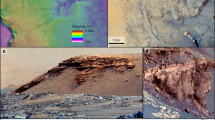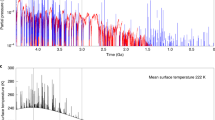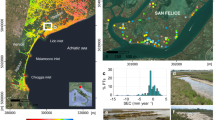Abstract
The presence of perennially wet surface environments on early Mars is well documented1,2, but little is known about short-term episodicity in the early hydroclimate3. Post-depositional processes driven by such short-term fluctuations may produce distinct structures, yet these are rarely preserved in the sedimentary record4. Incomplete geological constraints have led global models of the early Mars water cycle and climate to produce diverging results5,6. Here we report observations by the Curiosity rover at Gale Crater indicating that high-frequency wet–dry cycling occurred in early Martian surface environments. We observe exhumed centimetric polygonal ridges with sulfate enrichments, joined at Y-junctions, that record cracks formed in fresh mud owing to repeated wet–dry cycles of regular intensity. Instead of sporadic hydrological activity induced by impacts or volcanoes5, our findings point to a sustained, cyclic, possibly seasonal, climate on early Mars. Furthermore, as wet–dry cycling can promote prebiotic polymerization7,8, the Gale evaporitic basin may have been particularly conducive to these processes. The observed polygonal patterns are physically and temporally associated with the transition from smectite clays to sulfate-bearing strata, a globally distributed mineral transition1. This indicates that the Noachian–Hesperian transition (3.8–3.6 billion years ago) may have sustained an Earth-like climate regime and surface environments favourable to prebiotic evolution.
This is a preview of subscription content, access via your institution
Access options
Access Nature and 54 other Nature Portfolio journals
Get Nature+, our best-value online-access subscription
$29.99 / 30 days
cancel any time
Subscribe to this journal
Receive 51 print issues and online access
$199.00 per year
only $3.90 per issue
Buy this article
- Purchase on Springer Link
- Instant access to full article PDF
Prices may be subject to local taxes which are calculated during checkout




Similar content being viewed by others
Data availability
All data are available in the NASA Planetary Data System (https://pds.nasa.gov/) Geoscience Node in the Mars Science Laboratory directory (https://pds-geosciences.wustl.edu/missions/msl/) or Supplementary Information.
References
Ehlmann, B. L. & Edwards, C. S. Mineralogy of the Martian surface. Annu. Rev. Earth Planet. Sci. 42, 291–315 (2014).
Vasavada, A. R. Mission overview and scientific contributions from the Mars Science Laboratory Curiosity rover after eight years of surface operations. Space Sci. Rev. 218, 14 (2022).
Kite, E. S. Geologic constraints on early Mars climate. Space Sci. Rev. 215, 10 (2019).
Sheldon, N. D. & Tabor, N. J. Quantitative paleoenvironmental and paleoclimatic reconstruction using paleosols. Earth Sci. Rev. 95, 1–52 (2009).
Wordsworth, R. The climate of early Mars. Annu. Rev. Earth Planet. Sci. 44, 381–408 (2016).
Ramirez, R. M. & Craddock, R. A. The geological and climatological case for a warmer and wetter early Mars. Nat. Geosci. 11, 230–237 (2018).
Campbell, T. D. et al. Prebiotic condensation through wet–dry cycling regulated by deliquescence. Nat. Commun. 10, 4508 (2019).
Becker, S. et al. Wet–dry cycles enable the parallel origin of canonical and non-canonical nucleosides by continuous synthesis. Nat. Commun. 9, 163 (2018).
Farley, K. A. et al. In situ radiometric and exposure age dating of the Martian surface. Science 343, 1247166 (2014).
Goodwin, A., Garwood, R. J. & Tartèse, R. A review of the “Black Beauty” Martian regolith breccia and its Martian habitability record. Astrobiology 22, 755–767 (2022).
Guzewich, S. D. et al. 3D simulations of the early Martian hydrological cycle mediated by a H2–CO2 greenhouse. J. Geophys. Res. Planets 126, e2021JE006825 (2021).
Kamada, A., Kuroda, T., Kasaba, Y., Terada, N. & Nakagawa, H. Global climate and river transport simulations of early Mars around the Noachian and Hesperian boundary. Icarus 368, 114618 (2021).
Kite, E. S., Steele, L. J., Mischna, M. A. & Richardson, M. I. Warm early Mars surface enabled by high-altitude water ice clouds. Proc. Natl Acad. Sci. USA 118, e2101959118 (2021).
Turbet, M. & Forget, F. 3-D Global modelling of the early martian climate under a dense CO2 + H2 atmosphere and for a wide range of surface water inventories. Preprint at https://arxiv.org/abs/2103.10301 (2021).
Steakley, K., Murphy, J., Kahre, M., Haberle, R. & Kling, A. Testing the impact heating hypothesis for early Mars with a 3-D global climate model. Icarus 330, 169–188 (2019).
Stucky de Quay, G., Goudge, T. A., Kite, E. S., Fassett, C. I. & Guzewich, S. D. Limits on runoff episode duration for early Mars: integrating lake hydrology and climate models. Geophys. Res. Lett. 48, e2021GL093523 (2021).
Grotzinger, J. P. et al. Deposition, exhumation, and paleoclimate of an ancient lake deposit, Gale Crater, Mars. Science 350, aac7575 (2015).
Rapin, W. et al. An interval of high salinity in ancient Gale Crater lake on Mars. Nat. Geosci. 12, 889–895 (2019).
Schieber, J. et al. Mars is a mirror—understanding the Pahrump Hills mudstones from a perspective of Earth analogues. Sedimentology 69, 2371–2435 (2022).
Milliken, R. E., Grotzinger, J. P. & Thomson, B. J. Paleoclimate of Mars as captured by the stratigraphic record in Gale Crater. Geophys. Res. Lett. 37, L04201 (2010).
Bibring, J.-P. et al. Global mineralogical and aqueous mars history derived from OMEGA/Mars Express data. Science 312, 400–404 (2006).
Lasser, J., Nield, J. M. & Goehring, L. Surface and subsurface characterisation of salt pans expressing polygonal patterns. Earth Syst. Sci. Data 12, 2881–2898 (2020).
Goodall, T. M., North, C. P. & Glennie, K. W. Surface and subsurface sedimentary structures produced by salt crusts. Sedimentology 47, 99–118 (2000).
Goehring, L., Conroy, R., Akhter, A., J. Clegg, W. & Routh, A. F. Evolution of mud-crack patterns during repeated drying cycles. Soft Matter 6, 3562–3567 (2010).
Goehring, L. Evolving fracture patterns: columnar joints, mud cracks and polygonal terrain. Phil. Trans. R. Soc. Math. Phys. Eng. Sci. 371, 20120353 (2013).
Sadler, P. M. Sediment accumulation rates and the completeness of stratigraphic sections. J. Geol. 89, 569–584 (1981).
Daniels, J. M. Floodplain aggradation and pedogenesis in a semiarid environment. Geomorphology 56, 225–242 (2003).
Kraus, M. J. Paleosols in clastic sedimentary rocks: their geologic applications. Earth Sci. Rev. 47, 41–70 (1999).
Stein, N. et al. Desiccation cracks provide evidence of lake drying on Mars, Sutton Island member, Murray Formation, Gale Crater. Geology 46, 515–518 (2018).
Baccolo, G. et al. Jarosite formation in deep Antarctic ice provides a window into acidic, water-limited weathering on Mars. Nat. Commun. 12, 436 (2021).
Niles, P. B. & Michalski, J. Meridiani Planum sediments on Mars formed through weathering in massive ice deposits. Nat. Geosci. 2, 215–220 (2009).
Becker, S. et al. Unified prebiotically plausible synthesis of pyrimidine and purine RNA ribonucleotides. Science 366, 76–82 (2019).
Higgs, P. G. The effect of limited diffusion and wet–dry cycling on reversible polymerization reactions: implications for prebiotic synthesis of nucleic acids. Life 6, 24 (2016).
Ross, D. S. & Deamer, D. Dry/wet cycling and the thermodynamics and kinetics of prebiotic polymer synthesis. Life 6, 28 (2016).
Bristow, T. F. et al. Clay mineral diversity and abundance in sedimentary rocks of Gale Crater, Mars. Sci. Adv. 4, eaar3330 (2018).
Bishop, J. L. et al. What the ancient phyllosilicates at Mawrth Vallis can tell us about possible habitability on early Mars. Planet. Space Sci. 86, 130–149 (2013).
Pedreira-Segade, U., Feuillie, C., Pelletier, M., Michot, L. J. & Daniel, I. Adsorption of nucleotides onto ferromagnesian phyllosilicates: significance for the origin of life. Geochim. Cosmochim. Acta 176, 81–95 (2016).
Clark, B. C. & Kolb, V. M. Macrobiont: cradle for the origin of life and creation of a biosphere. Life 10, 278 (2020).
Grotzinger, J. P. & Milliken, R. E. in Sedimentary Geology of Mars Vol. 102, (SEPM Society for Sedimentary Geology) 1–48 (2012).
Knoll, A. H. Paleobiological perspectives on early microbial evolution. Cold Spring Harb. Perspect. Biol. 7, a018093 (2015).
Thomson, B. J. et al. Constraints on the origin and evolution of the layered mound in Gale Crater, Mars using Mars Reconnaissance Orbiter data. Icarus 214, 413–432 (2011).
Le Deit, L. et al. Sequence of infilling events in Gale Crater, Mars: results from morphology, stratigraphy, and mineralogy. J. Geophys. Res. Planets 118, 2439–2473 (2013).
Grotzinger, J. P. et al. Mars Science Laboratory Mission and science investigation. Space Sci. Rev. 170, 5–56 (2012).
Maurice, S. et al. The ChemCam instrument suite on the Mars Science Laboratory (MSL) rover: science objectives and mast unit description. Space Sci. Rev. 170, 95–166 (2012).
Wiens, R. C. et al. The ChemCam instrument suite on the Mars Science Laboratory (MSL) rover: body unit and combined system tests. Space Sci. Rev. 170, 167–227 (2012).
Clegg, S. M. et al. Recalibration of the Mars Science Laboratory ChemCam instrument with an expanded geochemical database. Spectrochim. Acta Part B 129, 64–85 (2017).
Rapin, W. et al. Quantification of water content by laser induced breakdown spectroscopy on Mars. Spectrochim. Acta Part B 130, 82–100 (2017).
Schieber, J. et al. Engraved on the rocks—Aeolian abrasion of Martian mudstone exposures and their relationship to modern wind patterns in Gale Crater, Mars. Depositional Rec. 6, 625–647 (2020).
Hartmann, W. K. & Neukum, G. Cratering chronology and the evolution of Mars. Space Sci. Rev. 96, 165–194 (2001).
Quantin-Nataf, C., Craddock, R. A., Dubuffet, F., Lozac’h, L. & Martinot, M. Decline of crater obliteration rates during early Martian history. Icarus 317, 427–433 (2019).
Acknowledgements
We thank A. Vasavada and A. Fraeman for discussions; and T. Goudge and J. Bishop for the comments and review. The data used are available in the NASA Planetary Data System Geoscience Node in the Mars Science Laboratory directory (https://pds-geosciences.wustl.edu/missions/msl/). This project was supported in the United States by NASA’s Mars Exploration Program and in France is conducted under the authority of CNES. Mastcam mosaics were processed by the Mastcam team at Malin Space Science Systems. E.S.K. funding by NASA grant 80NSSC22K0731. L.M.T. funding as a Mars Science Laboratory team member is provided by the CSA.
Author information
Authors and Affiliations
Contributions
W.R. and G.D. equally led the writing of the paper. W.R., G.D., B.C.C., J.S., L.C.K., L.M.T., P.J.G., P.-Y.M. and J.L. contributed to methodology, investigation and data processing. O.G. and N.L.L. are the leads of the ChemCam instrument investigation. J.S. and E.S.K. provided significant contributions to the writing and reviewing of the paper. All co-authors provided helpful comments and inputs to the paper.
Corresponding author
Ethics declarations
Competing interests
The authors declare no competing interests.
Peer review
Peer review information
Nature thanks Janice Bishop and Timothy Goudge for their contribution to the peer review of this work. Peer reviewer reports are available.
Additional information
Publisher’s note Springer Nature remains neutral with regard to jurisdictional claims in published maps and institutional affiliations.
Extended data figures and tables
Extended Data Fig. 1 Context of observations in Gale crater, Mars.
Stratigraphic context (left) of the lower portion of Mount Sharp and map (right) showing Curiosity rover traverse (white) on the High Resolution Imaging Science Experiment (HiRISE) base map overlaid with Compact Reconnaissance Imaging Spectrometer for Mars (CRISM) S-index, which tracks sulfates (shaded yellow). Red rectangle shows the location of close-up map and detailed stratigraphy (Extended Data Fig. 3b).
Extended Data Fig. 2 Larger color image of bedrock with polygonal ridges for context.
MastCam image (mcam100270) and close-ups (a,b and c) with rectangle locations of close-up view from Fig. 1. Close-ups (b,c) show bedrock 10 to 20 meters away where regularly spaced ridges and nodules can be observed supporting lateral extension of the same polygonal pattern although camera resolution prevents detailed geometrical analysis at this distance.
Extended Data Fig. 3 Local stratigraphic context of the examined section.
Close-up map of the examined sections along the rover traverse with location of the observed polygonal pattern (red circles) and associated geochemical measurements (red triangle and diamond, see Figs. 2, 3) (a); as well as general stratigraphic column for context with detailed log facies for East (Extended Data Fig. 9), Medium (Extended Data Fig. 10), and West (Extended Data Fig. 11) sections (b). Other locations with possible polygonal ridges as incipient or altered variants are annotated in Extended Data Fig. 12. The approximate distance of 200 m and 220 m between the adjacent sections centers is annotated on top (b). Facies are drawn based on available images from Mastcam M34/M100, MAHLI and ChemCam RMI. Nodular features within bedrock interpreted as chemical deposits are highlighted in red, whereas physical sedimentary structures are shown in blue. Sedimentary structures were rarely observed and the host rock of chemical deposits was mostly smooth and featureless. Geochemical data from polygonal ridges are represented with triangle (a and b). Location of ChemCam LIBS observations on bedrock are shown in the “CCAM obs.” column with a red cross where points analyzed chemical deposits and blue dot for host rock. Locations of APXS and MAHLI observations are also highlighted the same way, with a cross for chemical deposits and circle for host bedrock.
Extended Data Fig. 4 Polygonal ridges pattern analysis.
Top view of bedrock from sol 3154 generated using Onsight, with circles representing marked polygon sizes (blue) and junctions (yellow dots) connected to well-expressed (solid lines) and uncertain ridges (dashed lines) forming the pattern mapped on image (a). Red contour represents the area covered on Fig. 1e, and white rectangles areas for polygon size statistics (Supplementary information Table 1). Top view with extended context shows the area of analysis along with the location of closeups where polygonal ridges are observed in the distance (b). Elevation change is indicated by 1 m contour lines (yellow) to estimate the thickness of the observable strata from this location. Distribution of junction angles for well-expressed ridges only (solid red) and all ridges (dashed red) with gaussian fit (c). Distribution of polygon sizes and fit with Poisson probability distribution (d), see Supplementary information Table 1.
Extended Data Fig. 5 Flux of impacts on Mars through time.
Curves representing the impact rate chronology on Mars based on cumulative density of craters with D>1 km per unit area (a). This model is based on the equation from the crater chronology49,50 giving the cumulative number of craters larger than 1 km as N(1) = 5.44 × 10−14 [exp(6.93 T) − 1] + 8.38 × 10−4 T. The derivative of this function gives the flux of impact craters larger than 1 km over time (b) is given by the equation: N’(1) = 3.77 × 10−13 [exp(6.93 T) − 1] + 8.38 × 10−4 T. This curve presents a strong decrease in intensity of cratering with time which can be used as a proxy for extra-terrestrial material accretion with time. The link between the flux of impact craters of a given size and the accretion flux of the planet is then shown as a gradient bar (c) that is represented on Fig. 4 in the main text.
Extended Data Fig. 6 APXS data bedrock and diagenetic features.
CaO (a) and MgO (b) versus SO3 content for bedrock and diagenetic features in the investigated section. Resistant nodules, forming collectively nodular bedrock, show MgO and SO3 enrichment. The data only includes relatively clean, dust-free targets. List of target names for bedrock: Gourdon, Bardou_DRT, Ribagnac_DRT, Chenaud_DRT, Monpazier, Plaisance_DRT, Monsec_DRT. For veins/coating: Terrasson_Lavilledieu, Festalemps_DRT, Quinsac, Biras, Pezuls. For resistant bedrock: Gardonne_DRT, Simeyrols, Rouffignac, Bosset, Bosset_offset, Nabirat, Sarlande, Salagnac, Le_Bugue.
Extended Data Fig. 7 ChemCam images of fine-grained host bedrock.
The bedrock matrix typically composed of a light-colored smooth-textured mudstone.
Extended Data Fig. 8 ChemCam images of nodular bedrock.
Salt-bearing concretions are widespread and abundant in the examined section.
Extended Data Fig. 9 Stratigraphic log of East section.
Lumped nodules organized in polygonal ridges (dotted lines) on bedrock block (a, sol 3137 Montaut). Lumped nodules forming possible incipient ridges (dotted lines) on bedrock (b, sol 3137 Montignac). Irregular nodules forming possible incipient or altered ridges (dotted lines) observed within nodular bedrock (c, sol 3117 drive_direction). Laminated bedrock with variably coalescent nodular texture (d, sol 3119 allas_les_mines). Aligned, variably coalescent micro-nodules within laminar bedded facies (e, sol 3112 garreloup).
Extended Data Fig. 10 Stratigraphic log of Medium section.
Bedrock with evenly distributed dendritic nodules (a, sol 3147 workspace). Close-up image of a dendritic nodule showing jagged, multifaceted, multi-centimeter texture (b, MAHLI target Nabirat 25 cm standoff). Incipient polygonal ridges (dotted lines) on bedrock (c, sol 3139 workspace). Dendritic nodules (d, MastCam on Vayres).
Extended Data Fig. 11 Stratigraphic log of West section.
Partially coalescent nodules and laminar bedded facies (a, sol 3170 Organized_nodules). Nodular bedrock and laminar bedded facies adjascent to smooth or laminated bedrock at Pontours location (b, sol 3163 drill_area_context). Large, polymorphic vacuolar nodules (c, sol 3161 workspace). Coalescent nodules aligned in planar beds (d, sol 3158 diagenetic_transition). Incipient polygonal ridges (dotted lines) on bedrock (e, sol 3151 workspace).
Supplementary information
Supplementary Information
This file contains Supplementary Tables 1–3.
Rights and permissions
Springer Nature or its licensor (e.g. a society or other partner) holds exclusive rights to this article under a publishing agreement with the author(s) or other rightsholder(s); author self-archiving of the accepted manuscript version of this article is solely governed by the terms of such publishing agreement and applicable law.
About this article
Cite this article
Rapin, W., Dromart, G., Clark, B.C. et al. Sustained wet–dry cycling on early Mars. Nature 620, 299–302 (2023). https://doi.org/10.1038/s41586-023-06220-3
Received:
Accepted:
Published:
Issue Date:
DOI: https://doi.org/10.1038/s41586-023-06220-3
This article is cited by
-
Geological evidence for multiple climate transitions on Early Mars
Nature Geoscience (2024)
Comments
By submitting a comment you agree to abide by our Terms and Community Guidelines. If you find something abusive or that does not comply with our terms or guidelines please flag it as inappropriate.



